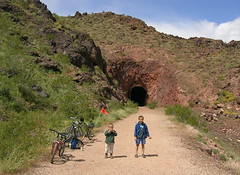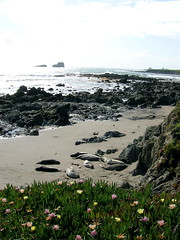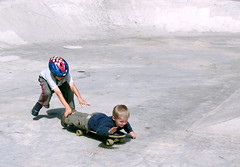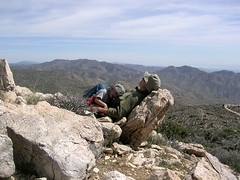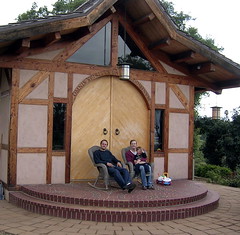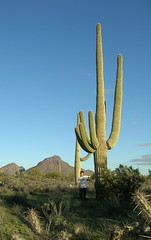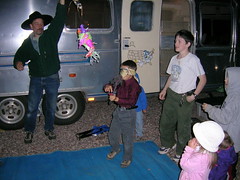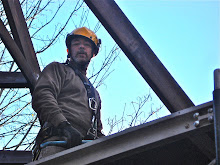Saturday, April 30, 2005
Railroad bike trail
Kids fun
The Hindrichs', Escondido, CA
Saturday, April 09, 2005
resting - Keys View
Hinrichs family
SD Wild Animal Park
San Diego Wildlife park.
jumping cholla
Ventura to Grand Canyon
April 8, 2005
We’ve begun the great migration east, and tonight I write from the south rim of the Grand Canyon. I was here in 1978, with my 4-H club. In ’78 we hiked to the bottom of the canyon, camped for a week, and hiked back out. In 2005, while we camp on the rim, I am struck by how many people are using this park. Here we are in early April and the place is mobbed. I can’t imagine what it must be like in July. Are we loving this park to death? I don’t think so. The park service is doing a great job keeping the impact localized and minimized, and while the crowds on the rim can be overwhelming, one needs only hike down in to the canyon for a few hundred yards to leave the vast majority of them behind. Today Ansel and I hiked 5 miles round trip down the Hermit trail. We saw fewer than 10 other hikers in that time. The scenery from below the rim is many times more impressive than that the great washed hordes experience on the rim, yet few choose to partake. Ansel had a lesson in geology. I don’t think he’s capable of fully understanding the scope of what he’s seeing here, but I hope seeds are sewn that will sprout and grow later in his life. I do know that he now understands what “sedimentary” means. His favorite park of the hike was observing some animal tracks exposed in a block of sandstone. Since the stone is in a layer dated to 275 million years ago, the thought of an animal- living at the time of the dinosaurs- walking on a sandy beach and leaving tracks for us to find was pretty impressive to him. I like that.
A few Grand Canyon facts:
*the elevation on the south rim is around 7,000 feet. On the north rim it’s 8,000 feet.
*The average decline to the Colorado River is over one vertical mile.
*The canyon varies in width but averages 10 miles.
*It’s 277 miles long.
*The rock on the rim is limestone that’s 250,000,000 years old; the rock the river is currently working on eroding is 1.8 billion years old. The Earth is 5 billion years old.
*Most of the rock layers exposed on the canyon walls is sedimentary. It was laid down by a series ancient seas eons ago, then lifted to it’s current elevation by plate tectonics.
*The Colorado River didn’t even begin cutting the canyon until the Rocky Mountains were formed, some 60,000,000 years ago.
The Glen Canyon Dam, up-river from the Grand Canyon, has wreaked havoc on the river’s efforts to maintain the canyon and it’s pace of erosion. Water flowage used to surge to 90,000 cubit feet per minute during spring thaw. This huge amount of water kept the canyon cleansed and actively eroding. The flow rate now- while somewhat variable- averages 20,000 CFM. Lake Powell, behind the dam, causes the vast majority of the silt that the river carries to settle out before entering the canyon. This further reduced the ability of the water to erode. And since the lake is so deep- hundreds of feet- the water that passes under the dam is much colder than it used to be, as it comes from the bottom of the lake. This has caused the majority of the native fishery to vanish, as they can’t tolerate breeding in the 48 degree water. Still, the river is an amazingly powerful and beautiful force. Ansel wants desperately to raft down it. We will be back.
I last left you in Ventura, CA. One Saturday while there Ruth’s aunt Dorothy offered to watch the boys so that Ruth and I could tour the Gamble house in Pasadena. The gamble house- built for one of the founders of Procter and Gamble- was designed and built by Greene and Greene architects. The brothers Greene are generally thought to be the fathers of the Craftsman style of architecture. Building early in the 20th century, they bucked the ginger bread Victorian trend that was the rage, by reintroducing a celebration of skilled craftsmanship and fine hand made materials to the homebuilding process. There is amazing timber work here and we soaked it up. I have long appreciated the work of the Greene’s and this was like a trip to Mecca in some ways.
I believe the highlight of our visit to Ventura for the boys was a stop at a city park that has a great little skateboard park. Ansel is a budding skateboarder, and he had never ridden in a concrete park like this one. Rainer also got into the act- by riding Ansel’s board on his belly. The boys had a blast and so did we watching. No, I couldn’t resist, and yes, I’m okay.
We had a sweet visit with Ruth’s aunt Dorothy, and we were all sad to leave her, but grateful for our time together. We pointed the silver sausage north on highway 101, toward San Louis Obispo. The country began to change almost immediately north of Ventura. The area around San Louis is called the Irish Hills- and for good reason. Especially this year, they are green and rolling and beautiful. We found a regional park- El Charro- on highway 1 just out of town. Another gem of a public park.
About 30 miles further up highway 1 (one of the most beautiful drives I’ve ever had the pleasure to navigate) is the little village of San Simeon, right on the Pacific Ocean. About 80 years ago a guy named Hearst decided to build a little place on a hill above San Simeon on some land his family owned. It’s now known as Hearst Castle. We toured it in shifts our first full day in the area: Ruth gave me the chance to go through alone, then she and Ansel went through while Rainer and I visited a beach a bit further up the road where elephant seals were calving. We’ve learned that torturing Rainer with tours like this- full of seductive things he can’t touch- tortures us probably more, and so we find ways to provide for the common defense by finding other things for him to do. Besides, a beach full of sunbathing elephant seals isn’t something one sees every day in Wisconsin.
Hearst built his castle between the wars, when Europe was in a world of financial hurt, and was willing to part with just about any antiquity that could bring in needed cash. Many, many of these found their way to San Simeon. The place is a hodgepodge of old stuff- some dating back 2,000 years- and all extremely impressive. I especially liked the 500 year old timber ceilings taken from a castle in France, shipped here, and reinstalled over W R’s dining room, to impress his many guests from every walk of public life.
We accomplished a few other things in San Louis Obispo:
We did laundry. This happens about every 2 weeks on average. We’ve found it works best if I can entertain the boys somehow for a few hours while Ruth furiously chucks quarters in to washers and dryers, tying up 4 at a time. The boys and I went to look at some tide pools just up the coast. Ruth got 3 hours to herself (with 100 lbs of laundry..) and I herded the boys.
We visited a friend of Ruth’s from high school- Luther Johnson- who has lived out here for quite some time. Luther is a card and it was fun having dinner with him.
I visited Terry Turney who runs Pacific Post and Beam. This is a small timber framing shop that Terry has nurtured for 18 or so years here. It was fun talking with him, learning more about some of the interesting work they do, and about building timber frames in seismic zones, where sprinkler systems are mandatory in every house.
We had some down time at the campground, where there was a very nice playground. The boys love a good playground. They have honed the ability to spot one from a mile off while we’re driving, and so when we encounter a nice one we take the opportunity to expel a few ya yas.
From San Louis we headed inland, leaving the Pacific behind us. Our destination was Sequoia National Forest. The Sierra Nevada Mountains, in which the sequoias are located in the southern portion of, have had a tremendous amount of snow this year. The drive took us through more acres of irrigated fields- primarily in citrus. Just outside of Bakersfield we encountered hundreds of oil wells. Wonder why fuel prices aren’t lower here..?
We camped way on the south end of the forest near lake Isabella. To get to the giant Sequoias is usually a one hour drive over a pass to the north. We had been told the pass was closed due to snow, but we had to see for ourselves. And sure enough- there was enough snow up there that even our four wheel drive wouldn’t do the job. We got to within a few miles, but it was no soap. So we did a little sledding with some other vexed adventurers among some not so giant sequoias and fir trees, and enjoyed the fresh mountain air and sunshine.
The next day we bit the bullet and made the eight hour round trip drive to see the giants. It was worth every minute. These trees are nothing short of magnificent. There are Sequoias here that measure over 30’ in diameter at the base, and when they are measured 250 feet in the air they are still at 20’. There are trees here that have over 90,000 board feet of wood in them. When the loggers of the 19th century saw these magnificent trees they salivated, and it took years before concerned locals convinced Teddy Roosevelt to slow them down- even though the lumber yielded by the sequoia tree is virtually useless, as the grain runs diagonally, making it weak and very difficult to work. As it turns out, this flaw is most likely the tree’s savior, and it’s unfortunate the sequoia’s distant cousin the redwood doesn’t share it.
We would have liked to spend more time in and around the Sierras, but as they are all but impassable, we chose to move on. We again headed east, across desert, salt flats, and 2 more mountain chains, descending in to Death Valley. I thought Big Bend National Park was big; Death Valley has half again the acreage, at 1.3 million. It’s bigger than Rhode Island. The lowest land in Death Valley is 288 feet below sea level; there is a mountain range here with peaks above 11,000 feet. It was 90 degrees at “Badwater” while we were there, and in the 20’s up in the mountains. And this year especially- to say it is impressive is an understatement. For there has been rain in Death Valley. More than they’ve had in the last 100 years. It’s been steadily raining since last August, and the result this spring is an incredible flourish of blooming things. Death Valley is alive!
The campgrounds in Death Valley leave something to be desired. They are 10 acre gravel parking lots, holding hundreds of RV’s and a few hapless tent campers. When the wind comes up –which it does with ferocity here- it turns in to a dust storm, cutting visibility to almost zero. One can taste salt in the air during these events. We didn’t spend much time in the campground, but there’s so much else to do and see here it really didn’t matter. One day we toured “Scotty’s Castle”- a home built by a wealthy insurance magnate from back east- in partnership with a local scallywag named Death Valley Scotty. We also hiked around an ancient volcano’s rim, peering down in to the extinct cauldron far below. We drove up a 4WD road a few miles in search of solitude and nearly found it. We visited Badwater- the lowest place in North America, to wade in the salty shallow lake. This water will be gone by mid-summer: Death Valley got over 10” of rain this past season. It usually gets less than 2”. However it has over 100” of evaporation every year. Temperatures in the 130’s are not uncommon, and humidity is incredibly low. During our visit humidity levels never got above 5%. We could feel our skin cracking.
We climbed out of Death Valley and headed east again, through the mysterious area 51, filled with bizarre folk living in RV’s in the desert, spouting strange theories about government conspiracies covering up the landing of aliens here in the 1950’s. Area 51 is the desert version of the Bermuda triangle, and I was worried for a while when at a lunch stop there our water pump quit working. But the belt had simply come off, so the problem was fixed in short order, and my skepticism remains intact.
We drove around Las Vegas, headed toward a national recreation area on Lake Mead. I think the drivers here acquired their habits in L.A.
Lake Mead is deceptively large. Scale is difficult to judge here, as distances are so great, and mountains can be much farther away than they appear. Lake Mead is the result of Hoover Dam. Built in the 1930’s at the height of the depression, it truly is a marvel of engineering. The dam is over 700’ tall, 660’ thick at its base, has enough concrete a sidewalk around the equator, and has no reinforcing steel at all. The dam has a convex shape, bowed out in to the lake, and so the enormous thrust from the weight of the water pushing against it is effectively transferred to the mountains beside it. It’s in compression, just like good German timber frames. We toured the dam, walked across it from Nevada to Arizona and back, and called it a day.
The next day we ventured in to Sin City itself. Our excuse was that my friend Charlie had given us a bunch of passes to the monorail he worked on and we had to use them up. We enjoyed viewing the spectacle in human excess, took the boys to Circus Circus (a casino with an indoor amusement park), waited for the free pirate show in front of Treasure Island casino that was eventually cancelled due to wind, waited for the volcano down the strip to erupt but it never did, ate dinner we later got diarrhea from, and called it a day.
The next day the boys and I rode bikes along an old railroad right-of-way built to bring materials to the Hoover Dam construction site. While we were battered by the wind, we enjoyed biking through the 5 mountain tunnels we encountered. That night I took Ansel fishing at the pier on Lake Mead. Earlier Rainer and I had seen lots of striped bass at the marina near there, and there was plenty of action on the pier, but none of it happened to us. We still enjoyed hanging out on the pier for a few hours with the locals, observing and learning. I decided to get up early the following morning and use up the rest of the sardines we used for bait. This time I had the pier to myself and had a fish on in a few seconds. After a couple of more hours I had two on the stringer and called it a day. I learned why most folks only keep larger stripers. While my fish were 3-4 pounds each, they yielded only a pound of meat together. But I had fun catching them, even if cleaning them was a disappointment.
I returned to camp to hook up the Airstream, for the 5 hour trip south and east and then north again to Grand Canyon. After being here for a few days I can say that the staff here is a disappointment. I’m sure they are tired of dealing with tourists, but that is their business, so my advice would be to get over it. The prevailing attitude is that they are doing you a favor by taking your money and you are just an inconvenience in their day. The park’s signage is terrible. The busses- designed to alleviate traffic jambs (a worthy goal indeed) are poorly thought through in terms of rout and frequency. Again, I point my finger at the company hired to contract out most of the services. The rangers themselves are great.
Yesterday Ansel accompanied me for a hike into the canyon despite suffering from a cold. We chose to hike down Hermit’s trail, descending 1,800’ to a dripping spring, for a round trip distance of 5 miles. We observed the incredible geology close-up, seeing fossils and animal tracks left here some 275 million years ago. We rested in the “red rock”- a sandstone deposit making up perhaps the most colorful band of rock in the park. Here we found a creek that had cut it’s own canyon through the sandstone, creating fantastic and beautiful shapes. We had a mishap with the camera, and so we are currently back using the old standby gifted to us by Brad.
Today, Saturday April 9, we awoke to a few inches of snow. All the tent campers were furiously bugging out. I rolled over and turned up the thermostat. Life in the Airstream is good.
Western Sunset to the Sea
This long overdue blog entry comes from Ventura California: McGrath State Beach, to be precise. It’s Sunday evening and the boys are fast asleep. We’re about 60 miles from downtown L.A. (well within commute distance) and today we decided to go into the big bad city. The scale of this place is difficult to comprehend. We drove in last Thursday, coming from the east. It was solid city for well over 100 miles. We passed 4 or 5 downtowns driving in on 101; each bigger than Milwaukee’s. And none of them were THE downtown. The car truly rules here. Freeways are 6 lanes each way; rude drivers are the norm. After a while I just assumed I’d be cut off and my blood pressure began to stabilize.
The boys had a big day. We all did. We went to the La Brea Tar Pits which are right in the middle of Beverly Hills, a few blocks from Rodeo Drive. This is an underrated attraction. They’ve been pulling prehistoric bones out of open pits of naturally occurring tar for over 100 years. Over a million pounds of bones. The tar is the result of oil and gas deposits deep underground. It’s bizarre to see fresh areas of the park cordoned off because “up from the ground comes a bubblin’ crude..” Complete skeletons of long extinct species such as the saber tooth tiger and the mastodon, are assembled for us to see in perfect condition.
We’ve suffered through a few days of rain here, but it was sunny today, so after La Brea we took the occasion to drive down to Venice beach. Now here’s a spot to practice the finer points of people watching. I’m thoroughly convinced that if one were to perch there, and wait long enough, one would see every possible configuration of human perversion (and I mean that in a nice way..) known. There was a Jamaican guy jumping in to a pile of broken glass from a chair, on the sidewalk, for tips. Another guy was doing a Houdini imitation- allowing audience members to do their best wrapping him up- also for tips. They have a muscle beach there. A place for those who are buff and know it- as well as those who think they are buff- to show off what they got- or don’t got. There are roller bladders strutting, there are skateboarders (in a cool little skateboard park- that Ansel and I had to give a go. It was a zoo getting there and it cost $7 to park 5 blocks away but for three hours of entertainment it was worth every penny.
We’ve been visiting Ruth’s aunt Dorothy- one of the nicest ladies alive. She and her friend Lucy- both trained as schoolteachers in the upper mid-west- moved to Ventura in the late 1950’s for work. They bought a house together in 1960- where Dorothy still lives. Lucy sadly passed away two years ago. Dorothy has seen this community grow from a small farming community to a full- fledged member city of the southern California megalopolis.
Thursday March 24
We’re now up the coast, at the farthest point west we will achieve in this trip. We’ve been camped just off highway 1 near San Louis Obispo since Tuesday. The difference in topography between here and southern California is striking. They call this area the Irish Hills and for good reason- especially this year. The grass is green on the sparsely treed rolling hills. The Hearst family has a place just up the road a ways; back in the day they controlled over 300,000 acres in this area. The Hearst Corporation still runs cattle on 90,000 acres here. They look happy grazing on the Irish hillsides.
We chose to visit here not only for the scenery. Ruth has a classmate from high school living here: Luther Johnson. We had dinner with Luther last night and it was good to catch up. I also had a chance to visit the good folks at Pacific Post and Beam. Terry has been doing good work in this area for a long while. He’s a native Californian, and besides surfing tales, I learned about building in California during our afternoon chat: from massive plan requirements, to sprinkler systems in every home, to earth quake codes and how his structures have performed during the last few temblors.
But it’s been 5 weeks since I’ve had a chance to write. I’ll jump back to Tucson and try to catch up.
Shortly after I last wrote we celebrated Ansel’s 8th birthday. One of the Stoddart kids was celebrating a birthday on the same day, so we combined forces and had a wing ding. Ansel togged in his new western gear: cowboy shirt, bolo, and a lariat- all purchased at a western store in Deming NM. Connor Stoddart, turning 12, also enjoyed the western theme, which seemed appropriate partying among the saguaros. We had a piñata and the kids all enjoyed taking a whack at it. Turns out small piñatas are tougher to break than bigger ones, and we finally had to inflict the mortal wound with a knife. Earlier in the day the families went to Old Tucson studios- just down the road from our camp- where many an old western was shot, and where a kids oriented theme park now sucks money from hapless tourists, but not without providing a good time in exchange. (It’s actually a real bargain compared to most amusement parks.)
The day we parted company with the Stoddart’s my friend Tom Noll flew in from Florida to hang with us for a week. I’ve known Tom since our first day of college in 1980. We’re both “between things” right now, and we picked up right where we left off after a four month separation.
We were not blessed with terrific weather during Tom’s visit. This caused us to adjust our itinerary a few times. We first chose to head south to Patagonia Lake State Park, just out of Nogales, Arizona. From our camp a few miles north of the border we chose to drive to within a few feet of Mexico, park the truck, and walk into Nogales, Mexico for a day. There’s a “free zone” close to the border in to which Americans are allowed without visas or any of the other necessaries of travel further in to the country. While the zone is structured primarily for the tourist’s benefit, it was good for the boys to get a feel for the poverty- as well as the different way of life- that goes on here. Ansel chose to purchase a small trinket from a poor Indian child selling them on the street corner with his mother. He felt empathy for this child, and I think it’s good to expose him to that. While in Patagonia Tom and I had a chance to slip away for a good bushwhack hike up a mountain together. We found evidence of lots of rattlesnakes, and discovered a mysterious cairn on top of the mountain. Who built it? When was it built? We’ll never know, but it’s fun to think about.
From Nogales, again dodging raindrops, we drove back up to Tucson- this time landing at Colossal Cavern State Park- a tiny campground next to a really big cave. The cave tour was worthwhile as were the stories of bank robbers stashing loot there- loot that has never been found. We lucked in to a chili cook-off happening in the park over the weekend. Besides getting to taste a dozen or more samples of the best chili Tucson had to offer, we were treated to a fantastic trick roping exhibition, which served to heighten Ansel’s interest in figuring out how to use his lariat.
Tucson is wedged in a valley, between the east and west halves of the Saguaro National Park. We’d spent most of our time in the west unit, but the day my friend Charlie Tolman drove in from Las Vegas on his way to Dallas, we chose to meet him for a hike in the east unit. I’ve known Charlie since the mid-1970’s, and with Tom, it was like an old times reunion among the cacti. Charlie moved to Vegas a few years ago to take a job with Bombardier, working on the monorail there. That project is wrapping up, so now he’s taking the opportunity to move back to the Dallas area to work on a similar project at DFW. Charlie had to get to El Paso that night, so our visit was brief, but worthwhile. The next day Tom had to fly back to Florida, and after a rather hectic day running around the city in search of a lost airplane boneyard, we dropped him off at the airport, and our family was on our own again.
We hitched up the silver sausage and turned our sights southwest and headed toward Organ Pipe Cactus National Monument in very southern Arizona. Organ Pipe is another huge, beautiful park, featuring the tall cacti reminiscent of its namesake. The park borders Mexico, and in 2001 over 200,000 undocumented aliens- “UDAs”- passed through the park on their way in to the U.S. There are water stations for UDAs throughout the park, and visitors are warned against providing any kind of food or encouragement for them. We were also warned to keep our cars and bikes locked, and Ansel wanted to be sure his bike wasn’t used for an escape across the desert.
While Tom was visiting we had really wanted to take Ansel out for an overnight backpacking trip. The weather didn’t allow that to happen, but as it appeared we could string together two days with a chance of rain below 50%, I was determined to make it happen with Ansel in Organ Pipe. We consulted the rangers and plotted a safe route in to a mountain valley that once was home to a cattle ranch. Hiking in the park is not limited to trails. In fact, there are very few trails, so bushwhacking is expected. We were issued a pass for a particular zone: where we hiked and camped in that zone was entirely up to us. Backpacking campsites are wherever you can find them. Most folks choose to stay out on the plateau, where flat sites are abundant. We chose for a bit more vertical challenge. We followed the trail up to the old ranch and then headed up an arroyo with the goal of camping on a flat-looking “saddle” between two mountains. But what looked level from below was not, and we headed back down the arroyo to find a small but nice spot above a creek, where we cooked dinner and watched the sun disappear across the desert, the full moon rise over the mountains behind us, with the sound of coyotes howling in the distance.
The next morning began chilly and well before sunrise in our valley. Ansel and I ate a light breakfast and decided to scramble up the side of a mountain to watch the sunrise. Besides seeing an organ pipe in bloom and showing fruit (very early but perhaps brought on by the abundant rain this year) and an abundance of desert birds, we discovered that coming down steep slopes is actually more difficult than going up. But we made it back without major crises, and after exploring the creek bed and packing up the tent we hiked out to the trailhead, where Ruth and Rainer met us with a welcome picnic lunch. It’s these kind of experiences that I place a very high value on being able to provide for Ansel. He learned much on our 24 hour outing, and he still talks about it.
Continuing our route west along the border we headed next toward Yuma, on the Colorado River and the California frontier. Yuma is crawling with retirees this time of year, most of whom pilot huge RV’s and make a season of it. As a result there are lots of RV parks, but many of them don’t allow anyone under age 55. I find this absolutely bizarre. We camped on the California side of the river on BLM land. This was our first experience with this style of camping. We chose a designated camping area, but most of the folks out there just pull up a hunk of desert and park it. As we were driving in a localized but intense thunderstorm blew up and dumped sheets of rain on us. We saw some intense lightning, and upon reaching the camping area we discovered that lightning had struck a large area of dried reeds along the other side of the river and started a fire. The fire burned and intensified all evening and made for an interesting backdrop to our campsite on a lake. We could hear the fire consume last year’s foliage, and every once in a while a palm tree would ignite with a whoosh and an intense light.
While in Yuma we visited the old territorial prison. This proved to be a more interesting stop than I would have thought. The prison was built in the 1870s- by the prisoners- of stone and adobe, and used until the 1920’s The highlight for the boys was the “dark cell”, in which the most incorrigible prisoners were punished for bad behavior. I doubt either one of them will be “offending” chronically any time soon.
Our drive to and from the BLM campsite took us through date palm groves. We found one that grew organic dates and stopped for some. There were also many fruit orchards here. This part of the Imperial Valley relies heavily on irrigation from the Colorado River. In fact, we were to learn that the vast majority of California relies entirely on irrigation- water redirected from rivers to turn the desert in to the country’s food basket. A rather precarious arrangement in my humble opinion.
From Yuma, heading west across southern California, one crosses a great stretch of BLM land, including sand dunes that are heavily used by dune buggy riders (would that be dune buggers?) ATVers and dirt bikers. Don’t care much for that lot, but I guess they’re not doing irreparable harm on the sand. There are other places (such as the Sequoia National Forest) in the west where they are a real scourge, defacing land with abandon as if it’s their god given right.
Soon we begin to gain elevation rapidly, and find ourselves in the Laguna Mountains and the Cleveland National Forest. At 6,000 feet of elevation it gets kind of chilly at night, and we have the campground- with over 100 spots- to ourselves. We celebrated Ruth’s birthday here, taking the day off by not driving anywhere, baking a cake, and taking a nice hike from our site. The park shows signs of heavy use in warmer months. We learn it’s a cool mountain escape destination for southern Californians, and it’s a bit worse for the wear, but serves our needs nicely early in the season.
We drove down in to a valley north and east of our camp, in which Anza-Borrego State Park is located, next to the resort town of Borrego Springs. After all the rain California has gotten this winter the desert is in bloom and all of California seems to have turned out to see. We choose to hike up a steep path in to Hell Hole Canyon to see a palm oasis, and we are not disappointed by the scenery or the work out.
Heading west again the map shows we’ll finally run out of continent somewhere near San Diego. As luck would have it we have an invite to visit from fellow timber framers guild members Chris & Diane Feddersohn. Upon their recommendation we take up residence on the ocean at San Elijo State Beach, in their hometown of Cardiff by the Sea. This, as near as I can tell, is paradise. The weather fluctuates between 50 and 85 degrees, most years they get less than 20” of rain, the world comes to a stop every night at sunset time so folks can watch, there’s great seafood AND Mexican restaurants, and great groceries across the street from the beach. Besides the outrageous (I learned to use that word with discrimination in California. The natives say “outrageous” to indicate something is exceptionally good; I use it here to indicate something’s exceptionally ridiculous) property taxes, fuel costs, and driving habits of the natives, and oh yes the omnipresent threat of being swallowed up by the Pacific Ocean the next time a fault line sneezes- this place is just about perfect.
Chris & Diane treated us like visiting dignitaries. They were tour guides, hosts, and friends wrapped in to one fine package. Our first day out they escorted us to the San Diego Wildlife Park. This is a very large establishment- over 1,000 acres- that’s like a zoo, except that the majority of the animals are free to roam. Only the predators- lions and tigers- are segregated, lest they develop an appetite for gazelle.
Chris instructs at and is director of the woodworking school at Palomar College. He’s hosted several Guild workshops and hopes to host more. I’d love to hire on for the next one. Hint, hint. Anyway, the next day was Saturday, and Chris had to teach. Ansel and Rainer really wanted to visit the Pacific Southwest Railway Museum in Campo- a 1.5 hour drive east along the Mexican border. So we chose to make the drive that day, sparing Diane from the trip. The museum was interesting but generally unremarkable. The highlight was of course the train ride- in which the train followed a route the boys were familiar with from their “There Goes a Train” video. We had more close encounters with the border patrol along the drive to and from Campo- hopefully for the last time.
The next day we had a great late breakfast at a Mexican place with Chris & Diane, across from the beach just south of Cardiff. We were on our way south, to San Diego, to go whale watching out in the Pacific. I though the experience would be a bit touristy, but figured the boys would enjoy it. Well, I was wrong again. Seeing these spectacular creatures in their own habitat is an experience not to be missed. We spotted several pods of Baleen whales, migrating north from their calving grounds off the Baja coast, up to their summer feeding grounds in Alaska. When looking for whales one scans the ocean for their telltale spouts: the whale surfaces and clears its blow hole of water before inhaling. This will happen several times over a period of minutes, Then the whales show their tales, descending for a “sounding dive”, repeating the sequence in another 5 minutes or so. Our captain was respectful of the whales and understood their need for space and their habits. At one point he and a captain of a sister ship had to chase off a private boat whose owner was not so respectful. After our cruise, we went to dinner at a great seafood place on the ocean Chris & Diane knew about, just south of the harbor. We ended another fantastic day with a driving tour of old downtown San Diego- a city worth spending more time in.
While at San Elijo Beach, it was difficult to make time to just enjoy the beautiful sand and surf that was a short walk from our camping spot. But the boys and I managed to sneak in some time there, as well as at some tide pools up a ways at “Swami’s Beach” –where I gave our camera an unwelcome saltwater bath. This caused it’s untimely demise, and we were camera-less for a few days, until I could find a replacement. We did enjoy watching the surfers all up and down the coast, who were enjoying the unseasonably high surf. Despite severe yearnings I did not give it a try. After 4 days at San Elijo we said goodbye to Chris and Diane and headed inland, to Escondido, where the Hinrichs’ had some paying work for me.
Christy and Fritz Hinrichs are building a German “fachwerk” styled timber frame home in Escondido. Christy responded to the notice I ran in the Timber Framers Guild publication a year ago, and we’ve been playing tag ever since. When I E mailed her suggesting we were in the area she invited us to stop by. At first it was just to be a cordial visit, but she and Fritz decided to hire me to cut some difficult hip and jack rafters for their new house. We gladly accepted. Fritz grew up on this 5 acre piece of land a few minutes from downtown Escondido. His father gave them an acre of it on which to build their house. He began a number of years ago by building a wonderful timber framed studio, in which they have been living. Now, five years and two children later, they are working on a much more ambitious house project.
Their property is on a beautiful hilltop, surrounded by orange, tangelo, lemon and avocado trees. We were assured that snacking was encouraged and fruit was a tangible part of the compensation package. I delighted in taking breaks by strolling down to the tangelo tree, selecting and picking one, and eating it on the spot. I set to work immediately. There are 14 “compound” hip and jack timbers in their frame. At first Fritz asked me to lay out a few and cut one he could use as a model. But the day we got there he and the rest of the family came down with a nasty bug, and he soon asked me to complete all of the compound work. I did so in 4 days. All of the timber design was done by Tony Wall at Dietrich’s in Canada, so I was quite familiar with the drawings (having spent a month training on Dietrich’s last fall). My days were filled with the sweet smell of fresh cut fir and the taste of tangelos, working in the southern California spring sunshine. Not bad for a Midwestern boy.
Our first evening at the Hinrichs’ I went to visit Chris Feddersohn at nearby Palomar College. I’d heard raves over his wood shop there, and jumped at the invitation for a tour. The shop lived up to its reputation. Chris showed me around all of the shops, showed me the sawmill (and dedicated timber framed shed it resides in), which is used to saw “urban lumber”. The city of San Diego donates all trees removed from parks, etc. to the college. These trees- which in most cities are fed to a chipper- are sawn for lumber, which is used by the students for their projects. Because of the agreeable climate here, there are countless species of trees that have been introduced as ornamentals that would otherwise not grow here- as well as a few species that are native and that only grow here. What a great way to turn a sow’s ear into a silk purse. Chris also showed me the workshop projects that the Guild cut here, including a beautiful Japanese gate.
Ruth took the boys to Lego Land one day. This is a theme park near Escondido dedicated to all things Lego and entirely kid friendly. The boys had a blast by all accounts. Our evenings were filled with folk music. The Hinrichs are in to traditional English dancing, and are both accomplished folk musicians. One night they had a group over for a dance on their patio. Another night we jammed in their living room; I say “we” as they asked me to bring our banjimer. I strummed along with Fritz on the banjo and Christy on the guitar, and I believe I found the right note at least once per tune. After four days of solid cutting I had all of the compound pieces complete, and as the Hinrichs were still not feeling well we decided we’d best move on.
Our next stop was Joshua Tree National Park. Joshua Tree is in the mountains 100 miles directly east of L.A. I must confess to laboring under a misperception: I thought Joshua Trees were the oldest living trees on earth. While they can live to be several hundred years old, the Bristlecone Pines that live west of here along the Nevada desert hold that title, with the Methuselah tree at an estimated 4,600 years old (the oldest living thing in the world lives near here too: a Creosote bush living in the Mojave is estimated to be 11,000 years old). Joshua trees are not really trees at all, but are most closely related to orchids. They must have been the inspiration of Dr. Seuss, who lived near here in San Diego- as their shape shows up in many of his stories. All of the rain we’d been enduring was beginning to pay off: the Joshua Trees were in bloom, with huge cone shaped flower clusters that smell for all the world like bleu cheese.
The campground here had taken a severe beating from all the rain this winter, and given the state of funding for the national parks these days, it may be a while until it completely heals. We managed to sneak the silver sausage in to a site, and spent a few days exploring this large park. Hiking was high on our list. We were able to hike from our site into beautiful and strange places, including along earth quake fault lines- including the San Andreas, that runs right through the park. We took a drive one day toward an overlook that viewed across the valley to Palm Springs. On the way we came across a group of rock climbers dangling from some bizarrely shaped hunks of granite a hundred feet up. It was fun to watch, and we were able to dissuade Ansel by climbing on some more manageable rocks nearby. A family from SoCal pulled in across from us. Ansel is getting much better and quicker at making friends, which is great. In no time he had befriended their three kids, and he and Rainer spent a fair bit of time digging a hole. Truth be told this wasn’t any ordinary hole. In fact, the kids probably should have been issued a mining permit. Before long the smaller kids disappeared below it’s rim, and Ansel and Andrew- the oldest of their three- were at eyebrow depth. Just as the parents were going to call a halt a ranger came by and did it for us. The boys wrote out a “time capsule” note and buried it in the backfill, which took some of the edge off having to abandon their work.
We’ve found that we enjoy camping most in State and National parks, as well as other out of the way places more than in big RV parks. While the amenities most Rvers look for are missing in the national lands, the scenery is usually better, the folks staying there are more interesting, and the opportunities to learn from the experience are greatly expanded. There is a marked distinction between national Parks and national Forests. National forests are often less geared toward our kind of outdoor experiences- hiking, biking, and learning- and more geared toward motor sports, such as ATVing, dirt biking, and shooting. The west has literally millions of acres of national forest, and we have camped in several. In every case the management of the campground has been sub-par, and the overall experience was lacking. I attribute much of the trouble to the trend in contracting out the management of the campgrounds to private contractors, who have no interest in maintaining the facilities, and seem to have an equally lackadaisical approach to collecting fees. On more than one occasion we had to hunt down the employee who was responsible for collecting fees- and on more than one occasion we were unable to do so. The same trend is appearing in the National Parks, though as of yet to a lesser extent.
From the Dr. Seuss trees we headed west, toward the megalopolis. There is a mountain pass just west of Palm Springs that has over 4,000 full size power generating windmills in it. It’s surreal driving through this area: it reminded me of the Saguaro cacti, these large figures spaced across the landscape- except the windmills are many times bigger than the saguaro and have swirling arms. The pass is very windy and it’s good to see lemonade being made from it. We got in to the beach camp at Ventura after a rude introduction to driving on L.A. freeways.

